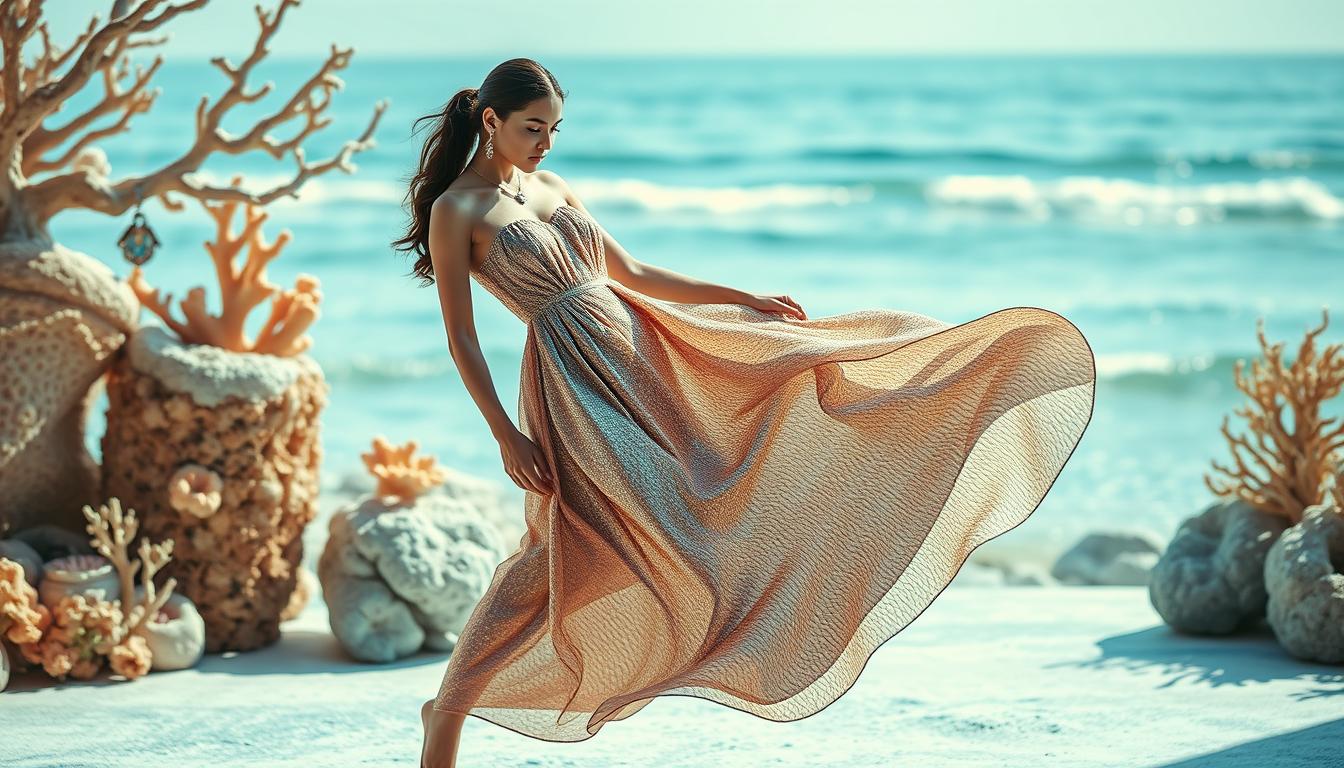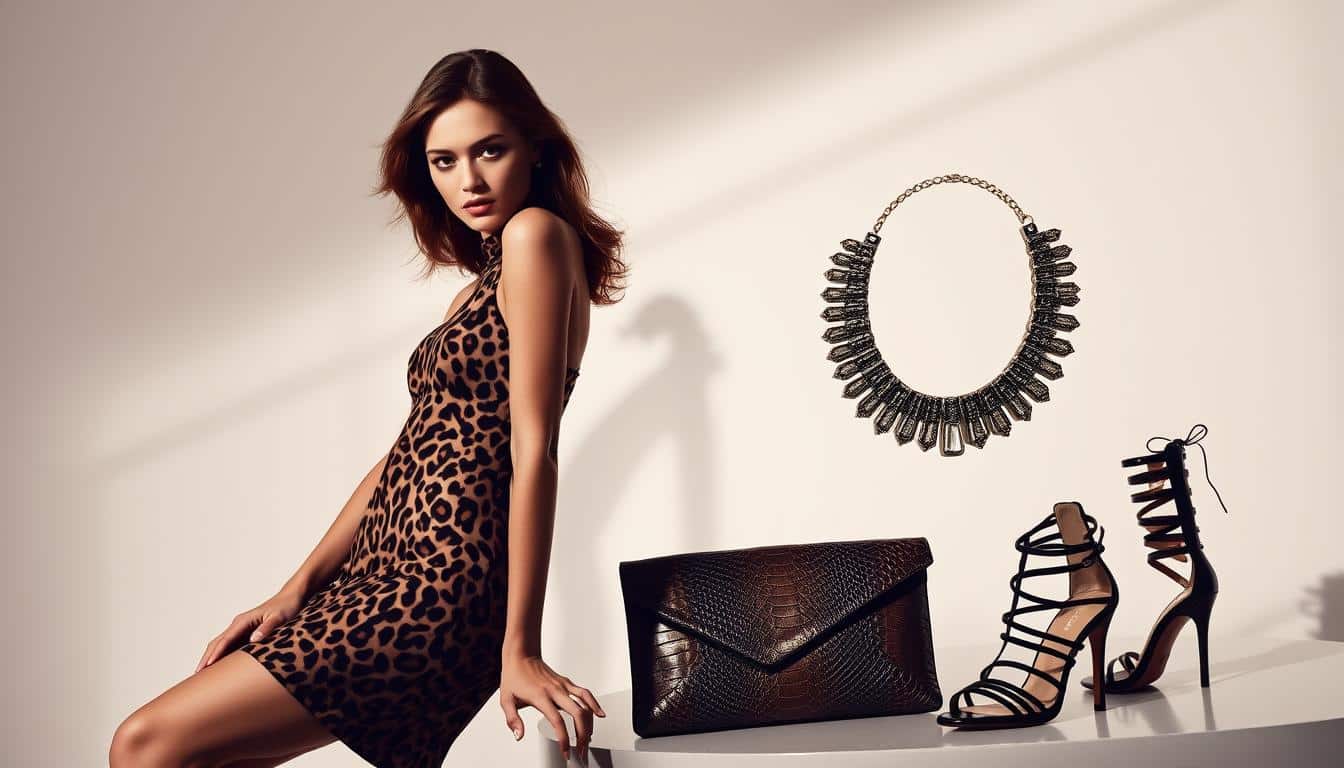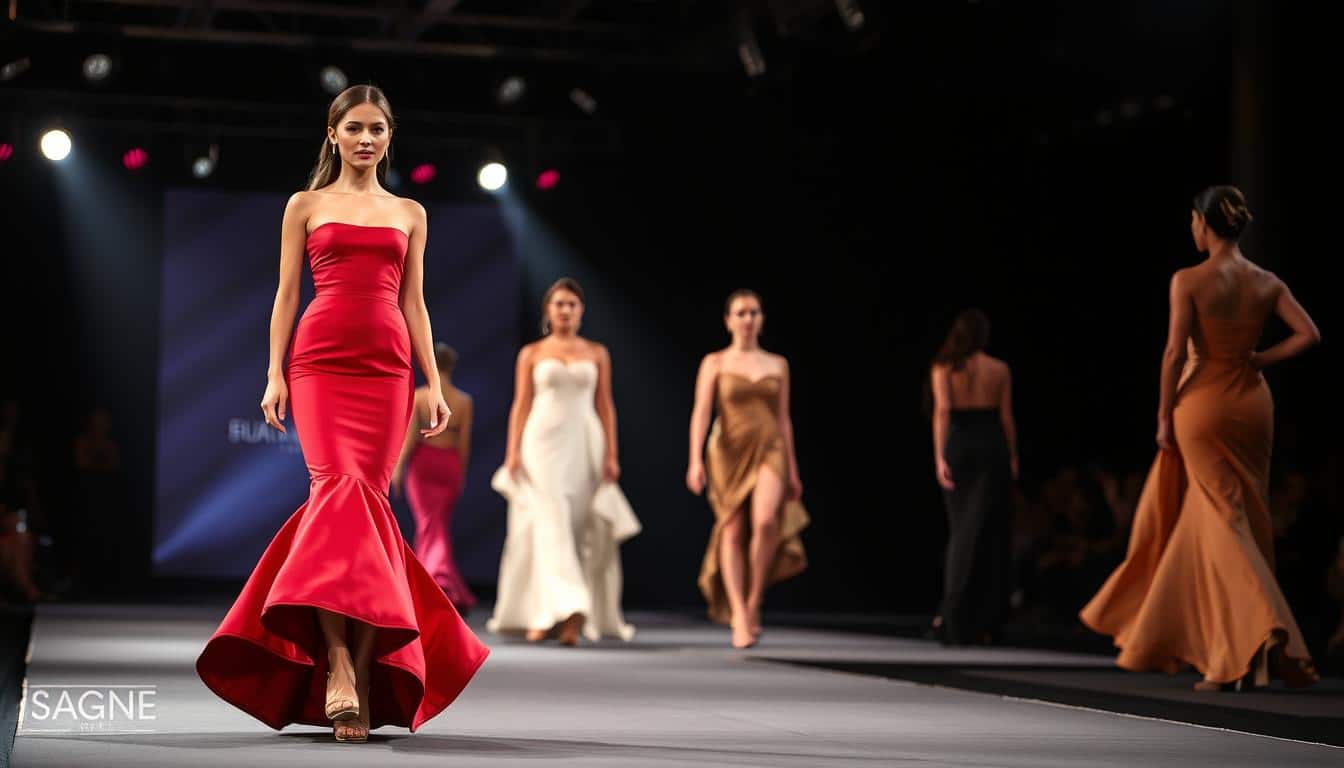Anúncios
Asymmetry in Clothing Designs is changing how Americans view their style day by day. This fashion trend varies from slight modifications, like an uneven hem, to bold statements such as one-shoulder tops. These styles are taking cues from popular trends on fashion runways and Instagram. It’s about making modern asymmetry wearable and up-to-date for everyone.
Anúncios
In this piece, we’ll dive into what asymmetry in design really means. We’ll look back at its history and its current appeal to shoppers in the United States. You’ll discover all sorts of garments, from tops with unique hems to clothes that drape differently. Plus, get tips on how to style these pieces for any occasion. We’ll even tackle smart shopping and how to take care of these unique items.
We want to help those who love fashion, whether you’re a consumer, enthusiast, or professional. You’ll find practical advice and examples that make embracing the asymmetrical trend simple. With our guidance, wearing standout pieces will feel natural and confident.
Anúncios
Key Takeaways
- Asymmetry in Clothing Designs adds visual interest and modern edge to outfits.
- The asymmetrical fashion trend ranges from subtle shifts to dramatic one-shoulder styles.
- Readers will learn history, styling tips, shopping pointers, and care advice.
- Content is geared to shoppers in the United States seeking wearable, standout pieces.
- Practical guidance helps translate runway modern fashion asymmetry into everyday looks.
What Is Asymmetry in Clothing Designs
Asymmetry in clothing steps away from the same old mirrored balance. Uneven hemlines, mismatched sleeves, one-shoulder cuts, and off-center closures are some ways designers catch our eyes. They mix beauty and practicality to shape outfits, direct where we look, and bring life to their creations.
Definition and key characteristics
Asymmetry in fashion means making clothes that aren’t the same on both sides on purpose. Look for uneven hems, sleeves of different lengths, tilted necklines, and seams that aren’t where you expect. This can help people move easier in their clothes or just make them look cool.
Designers play with asymmetry to get our attention. They use creative angles to make parts of the outfit stand out. This can make a simple dress look more interesting by drawing your eye to specific places.
How asymmetry differs from traditional symmetry in fashion
Normal clothes often look the same on both sides, with everything neatly matched up. This kind of symmetry makes outfits look formal and balanced. But when we talk about symmetry versus asymmetry in fashion, we’re comparing that orderliness to a more dynamic, engaging look.
If one sleeve is shorter or a hemline is diagonal, the whole outfit gets a more sculptured look. These changes give clothes a fresh, modern vibe. Designers use differences in symmetry to make their designs stand out and surprise us, all while keeping them easy to wear.
Historical influences and early examples
Asymmetrical fashion has roots in ancient clothing, like the Greek himation and Roman toga, which looked stylish thanks to their uneven folds. In the 20th century, designers like Madeleine Vionnet started making flowing clothes that moved with the body thanks to diagonal cuts.
Christian Dior also played with off-balance designs. In the 1980s and 1990s, designers Rei Kawakubo and Yohji Yamamoto made asymmetry a key part of high fashion. These shifts helped make unexpected designs more popular on the runway.
During Hollywood’s Golden Age, stars often wore one-shoulder gowns, adding glamour to asymmetry. Influences from Japan and Africa led Western designers to try new shapes and sizes. Thanks to better fabrics and cutting techniques, today’s designers can create even more complex and interesting asymmetrical clothes.
| Aspect | Symmetry | Asymmetry |
|---|---|---|
| Visual effect | Predictable, formal balance | Dynamic, focalized tension |
| Common elements | Matching sleeves, centered closures, even hems | Uneven hemlines, one-shoulder cuts, off-center details |
| Design intent | Uniform silhouette, classic proportions | Emphasize or disguise areas, create movement |
| Historical touchpoints | Traditional tailoring, classical evening wear | Greek draping, Vionnet bias cuts, Kawakubo runway shows |
| Construction demands | Balanced pattern matching, mirrored panels | Advanced draping, asymmetric patterning, technical textiles |
Why Asymmetry in Clothing Designs Is Trending Now
The fashion world is full of energy and movement. Designers are blending uneven cuts with classic styles to create something new. This mix of the familiar and the fresh explains the popularity of asymmetry. It surprises us, yet it’s still easy to wear.
Famous brands like Balenciaga and Proenza Schouler are showcasing asymmetric designs on world stages. Smaller, cutting-edge brands are also joining in with unique pieces. All these designs are creating a buzz and setting trends that fashion lovers and buyers are excited about.
The buzz doesn’t stop on the runway. On city streets, social media influencers are making these styles go viral. In cities like New York, photographers mix high-fashion and everyday brands to make stylish, relatable looks. Even with so many choices online, unique, uneven styles help some stand out.
People are looking for ways to show their unique style, especially after the pandemic. They’re drawn to clothes that are both personal and practical. Asymmetric dresses and tops are becoming popular because they look great and show off individuality.
Retailers are noticing this shift too. Stores like Zara are quickly adding more asymmetric styles. High-end brands are also getting more attention in fashion magazines. Searches for asymmetric styles are up, showing that people are curious and interested.
One reason asymmetry is so popular is that it’s practical. It doesn’t matter your budget; an asymmetric touch can update your look. Adding a slant to a dress or top can make your whole outfit feel new and modern.
| Trend Driver | How It Shows | Typical Price Points |
|---|---|---|
| Runway adoption | Asymmetric gowns, uneven lapels, experimental knits | Designer to high-end ready-to-wear |
| Social amplification | Street-style posts, short-form videos, influencer features | High-street to boutique labels |
| Consumer individuality | One-shoulder cuts, mixed hemlines, statement tops | Affordable staples to investment pieces |
| Retail response | Expanded assortments at Zara, & Other Stories, luxury houses | Mid-market and luxury |
| Search and editorial interest | Increased queries for specific asymmetric items; coverage in major magazines | All segments |
Adding a twist to what you already own is a simple way to update your style. This easy change is why asymmetry is catching on. It offers a fast track to a modern and stylish look.
Types of Asymmetrical Garments to Try
Asymmetry can make your outfit stand out. Start with simple things like buttons that aren’t in a straight line. Or, go all out with big, flowing designs. Here are some choices that show the power of different shapes and materials.
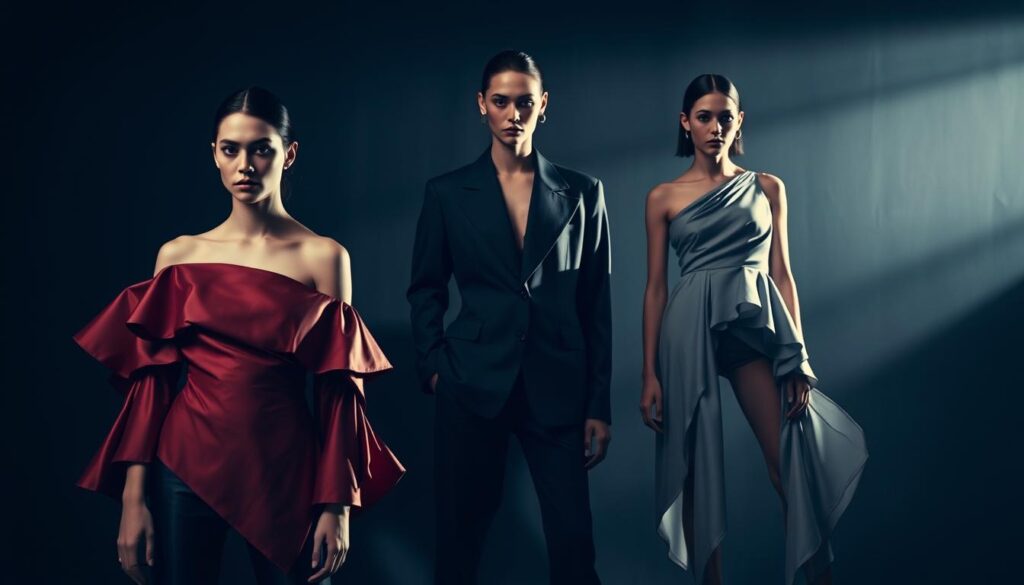
Asymmetrical tops and blouses
Asymmetrical tops have lots of styles: buttons down one side, pieces missing on the sides, slanted collars, and edges that don’t match. You can find them in soft silk that flows over the body or in stiff cotton that keeps its shape. Mix a shaped blouse with jeans or short pants for a sleek, new look.
One-shoulder dresses and tops
One-shoulder outfits are both timeless and new. They come as light tank tops, cozy sweaters, and fancy dresses. Some have one long sleeve, straps that are different, or parts cut out. They make your neck and shoulder look good and are stylish with a blazer.
Skirts and hemline variations
Skirts with uneven edges bring movement and a new look. Look for skirts with fronts and backs that are different lengths, layers that overlap in interesting ways, sides that don’t match, and skirts with lots of layers. A skirt that’s longer on one side can make one leg look longer and moves nicely as you walk.
Layered and draped asymmetrical silhouettes
Layered looks use lengths that aren’t the same and lots of fabric folds. Draped designs often have panels that go in different directions to create shapes. Famous designers like Rick Owens and Issey Miyake are experts at making these flowing designs. Soft materials like thin cotton and silk show off these layers best.
Here are some tips: Keep your patterns simple if your outfit has a lot of folds. Wear a showy top with simple jeans. Or, try a one-shoulder top with a snug blazer for a mix of tight and flowing.
How to Style Asymmetrical Pieces for Everyday Wear
Asymmetrical pieces make a wardrobe exciting. Plan around scale, movement, and focal points. This keeps your look polished, not messy.
Balancing proportions and creating a cohesive look
Match a big asymmetric top with slim bottoms. Pair an uneven hem skirt with something fitted. This keeps your look balanced.
Stick to similar colors or simple palettes. It helps the eye focus on the design, not chaos.
Good tailoring is key for these cuts. Even a small adjustment can make an outfit look intentional. If it’s too loose, think about altering it.
Mixing textures, patterns, and colors
Combine matte and satin textures to highlight shapes. Stick to 2-3 colors to keep things unified.
Solid colors work well on busy days. Use patterns wisely. A small pop of color, like on a belt or shoe, can add just the right touch.
Choosing accessories to complement asymmetry
Accessories should match the outfit’s unique shape. A single earring or an asymmetric set can reflect your look’s theme. Belts are great on asymmetric dresses for defining your waist.
Structured bags and sharp shoes add balance. Boots bring an edgy vibe. Make sure hair and makeup match your look’s key feature. Always check your outfit’s movement to ensure it looks good in action.
| Styling Need | Practical Tip | Best Accessory |
|---|---|---|
| Soften a bold asymmetric top | Pair with slim jeans and tuck at the front for shape | Pointed-toe flats |
| Anchor a flowing asymmetric dress | Add a waist-defining belt and a cropped jacket | Structured leather tote |
| Make a patterned asymmetric panel pop | Keep rest of outfit neutral and match one accent color | Minimalist single-statement earring |
| Wear dramatic draping casually | Balance with rugged footwear and a fitted top layer | Chunky ankle boots |
Occasion-Based Styling: Office, Casual, and Evening
Switching from day to night is easy with asymmetry. Just choose the right materials and sizes. At work, go for slight details. For weekends, try fun shapes. Nights out call for eye-catching choices. Here are some tips and brand suggestions to nail each look.
Professional approaches to asymmetrical workwear
In the office, stick to simple designs. Consider a blazer with a unique lapel, a skirt that’s longer in the back, or a subtly uneven top. Pick plain colors and classic fabrics to stay sleek.
Theory, Diane von Furstenberg, and J.Crew have elegant options for work. Focus on how your clothes fit. Proper tailoring makes sure your asymmetrical choices are suitable for work, not too casual.
Casual weekend outfits with asymmetrical accents
Weekends offer a chance to play with asymmetrical styles. Consider wearing a slanted tee with leggings, a wrap skirt with comfy shoes, or a sweater and jeans combo. Add ankle boots or white sneakers to keep it simple.
Check out Madewell and Everlane for easy-to-wear items. Balance your look by making one piece the star. This ensures your outfit looks planned.
Glamorous evening and event-ready asymmetrical looks
Evening wear calls for standout shapes. Choose dresses with wraps, high slits, or a unique shoulder. Try a jumpsuit with an asymmetrical top as a trendy gown option.
Alexander McQueen, Saint Laurent, and Oscar de la Renta are great for inspiration. Complete your ensemble with high heels, a minimalist purse, and eye-catching earrings. Don’t forget to get your outfit properly fitted.
Transition tips
Changing a casual asymmetrical top for the evening? Switch your flats for heels and add some necklaces. To make a bold evening item more subdued, wear a fitted blazer and simple jewelry for a less formal look.
Shopping Tips: Finding Flattering Asymmetrical Clothing
When shopping for asymmetrical clothing, follow a few rules to ensure they look great. Identify what features you want to show off, considering how slanted hems or unique necklines work with movement.
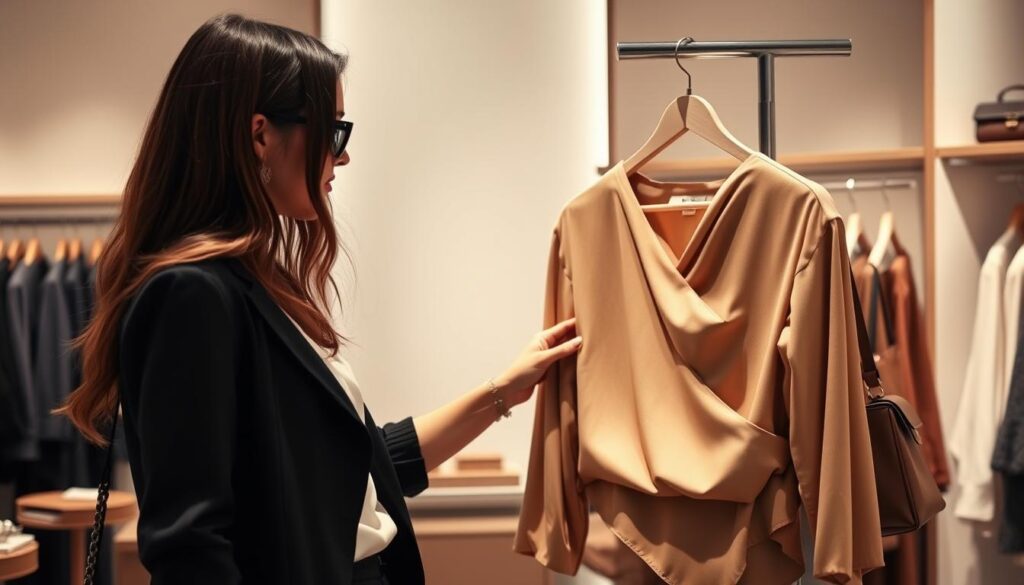
Fit considerations for different body types
Hourglass figures should try asymmetric wraps or belted styles to highlight their waist. Pear shapes look good in tops that draw the eye up, like one-shoulder styles or those with fancy shoulders.
Apple types can appear slimmer with vertical asymmetry and designs that fasten on the side. People with a rectangular body can add curves using layers and drapes that add motion.
Always check how clothes fit by moving around in them. Make sure asymmetrical hems are flattering and don’t strain the fabric. A tailor’s minor tweaks can elevate an asymmetrical item’s appearance significantly.
Fabric choices and construction quality
The fabric in asymmetrical clothing plays a big role. Pick stiff materials like cotton and crepe for sharp edges. For a flowy look, choose silk, chiffon, or jersey.
Examine how well the garment is made. Check for strong seams, especially along the shoulders and closures. Well-made edges and secure fastenings help the garment maintain its shape.
Budget-friendly finds versus designer investment pieces
Deciding between budget and designer asymmetric clothing helps with planning. Brands like Zara and H&M are great for trying out new styles without spending much.
High-end brands offer quality fabrics and construction. Investing in a few designer pieces can add lasting style to your wardrobe. Mix these with cheaper items for a balanced look.
Practical shopping tips
Look into return policies and read reviews with photos to understand how clothes fit various shapes. Small alterations can make a big difference in how asymmetrical pieces look on you. Adjusting a hem or strengthening a seam can make you love your purchase even more.
Care and Maintenance for Asymmetrical Fashion Pieces
Asymmetrical clothes need care to keep their unique shapes. Read the care label first, as these pieces often use delicate materials. A bit of care early on can save money on fixes later.
Washing and handling delicate drapes and seams
Always follow the instructions on the garment tag when washing. Use cold water and a gentle setting for machine washables, or choose to hand wash delicate items. Put delicate parts like mesh in a mesh bag to keep them safe.
Use a soft detergent and stay away from bleach. Shape the clothes while they’re still damp. Let them air dry on a flat surface or hang them on padded hangers to stop them from stretching.
Storing and pressing asymmetric garments without distortion
Use padded hangers for heavy clothes like coats. To care for items with uneven edges, fold them carefully with acid-free tissue or lay them flat. Change their position in your wardrobe often to keep them in good shape.
Instead of ironing, steam delicate fabrics gently. A tailor’s ham is great for pressing without squashing the garment’s shape. Keep these clothes out of the sun to avoid color fading.
When to seek professional alterations or repairs
Small adjustments by a skilled tailor can make a big difference. Experts can fix the fit or adjust the details. Choose someone who knows how to handle unique designs.
Fix problems like loose seams or decorations quickly to prevent worse issues. Regularly checking your clothes by a professional helps them last longer. Keep a routine, use garment bags for storage, and check your clothes often. This keeps your asymmetrical clothes looking great.
Celebrity and Designer Inspirations for Asymmetry
Paris and Milan’s runways have really spotlighted asymmetry. Rei Kawakubo at Comme des Garçons and Yohji Yamamoto creatively use imbalance to make standout silhouettes. Meanwhile, Alexander McQueen and Versace wow us with asymmetric gowns.
Stella McCartney and Proenza Schouler have turned these bold ideas into everyday wear.
Notable runway shows and signature designs
Do you recall the time when fashion week was all about asymmetric gowns and draped layers? Those shows brought us jackets and hems that really set the trends. These unique pieces serve as inspiration for fashion editors and buyers alike.
Celebrity street style and red carpet moments
Rihanna and Jennifer Lopez have made one-shoulder and asymmetric gowns popular on the red carpet. Zendaya takes risks with bold, avant-garde shapes. Hailey Bieber adds that cool vibe to daily outfits with asymmetric designs.
Celebs wearing asymmetry often inspire what we see in stores.
How to translate high-fashion asymmetry into wearable looks
Want high-fashion asymmetry in your daily outfit? Just choose one asymmetric item as your outfit’s highlight. A one-shoulder dress or an angled jacket can really update your look. Mix these eye-catching pieces with basics like jeans or nicely tailored pants.
Look at celebrities for tips on how to proportion things right. If you prefer something low-key, go easy on bold fabrics and stick to simpler colors. Or, if you’re up for making a statement, pick asymmetrical designs in timeless colors for flexibility.
For fresh inspiration, keep an eye on fashion week reporting in Vogue and W Magazine. Celebrity stylists often share easy-to-follow ideas on Instagram, combining runway trends and everyday style.
Conclusion
Asymmetry in clothing offers a unique twist to freshen up your outfits. It brings an intentional imbalance. Think uneven hems, one-shoulder styles, and layered pieces that catch the eye. This trend mixes high fashion, everyday style, and comfort into something that’s modern yet easy to wear.
Starting with asymmetry might seem daunting, but it’s quite simple. Begin with a single asymmetric top or accessory. Focus on good fit and quality materials. If you’re looking for something to last, consider a piece from designers like Alexander Wang or Proenza Schouler.
For casual or fancy events, it’s all about balance. Combine different textures and let an asymmetric piece be the standout. This will make your outfits exciting and unique.
Trying out asymmetry is all about having fun and seeing what suits you. You can go bold or keep it subtle. These pieces let you express yourself and give a fresh take on your usual style. To get more into asymmetric fashion, look up the latest fashion shows, test out a style that feels right, and share your finds online. Use hashtags to inspire others with your style discoveries.
FAQ
What is “Asymmetry in Clothing Designs”?
How does asymmetry differ from traditional symmetry in fashion?
Where did asymmetrical fashion come from?
Why is asymmetry trending now?
What types of asymmetrical garments should I try first?
How do I style asymmetrical pieces for everyday wear?
Can I wear asymmetry to work or formal events?
How should I shop for flattering asymmetric clothing based on my body type?
What fabrics and construction details matter for asymmetrical garments?
Are asymmetrical pieces expensive to maintain or alter?
Where can I find asymmetrical clothing at different price points?
Which celebrities and designers best showcase asymmetry?
How do I introduce asymmetry into a minimalist wardrobe?
Any quick care tips to keep asymmetric garments looking their best?
How can I make a dramatic runway asymmetrical look wearable for everyday?
Content created with the help of Artificial Intelligence.

